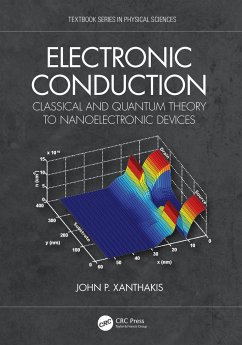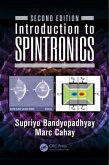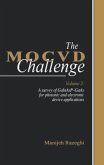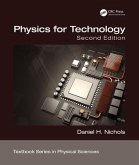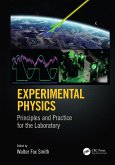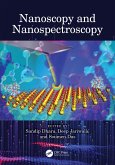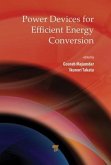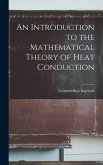- Gebundenes Buch
- Merkliste
- Auf die Merkliste
- Bewerten Bewerten
- Teilen
- Produkt teilen
- Produkterinnerung
- Produkterinnerung
This book provides a concise, complete introduction to the fundamental principles of electronic conduction in microelectronic and nanoelectronic devices, with an emphasis on integrating the quantum aspects of conduction.
Andere Kunden interessierten sich auch für
![Introduction to Spintronics Introduction to Spintronics]() Supriyo BandyopadhyayIntroduction to Spintronics180,99 €
Supriyo BandyopadhyayIntroduction to Spintronics180,99 €![The MOCVD Challenge The MOCVD Challenge]() Manijeh RazeghiThe MOCVD Challenge447,99 €
Manijeh RazeghiThe MOCVD Challenge447,99 €![Physics for Technology, Second Edition Physics for Technology, Second Edition]() Daniel H NicholsPhysics for Technology, Second Edition189,99 €
Daniel H NicholsPhysics for Technology, Second Edition189,99 €![Experimental Physics Experimental Physics]() Experimental Physics161,99 €
Experimental Physics161,99 €![Nanoscopy and Nanospectroscopy Nanoscopy and Nanospectroscopy]() Nanoscopy and Nanospectroscopy157,99 €
Nanoscopy and Nanospectroscopy157,99 €![Power Devices for Efficient Energy Conversion Power Devices for Efficient Energy Conversion]() Gourab MajumdarPower Devices for Efficient Energy Conversion147,99 €
Gourab MajumdarPower Devices for Efficient Energy Conversion147,99 €![An Introduction to the Mathematical Theory of Heat Conduction An Introduction to the Mathematical Theory of Heat Conduction]() Leonard Rose IngersollAn Introduction to the Mathematical Theory of Heat Conduction32,99 €
Leonard Rose IngersollAn Introduction to the Mathematical Theory of Heat Conduction32,99 €-
-
-
This book provides a concise, complete introduction to the fundamental principles of electronic conduction in microelectronic and nanoelectronic devices, with an emphasis on integrating the quantum aspects of conduction.
Hinweis: Dieser Artikel kann nur an eine deutsche Lieferadresse ausgeliefert werden.
Hinweis: Dieser Artikel kann nur an eine deutsche Lieferadresse ausgeliefert werden.
Produktdetails
- Produktdetails
- Verlag: CRC Press
- Seitenzahl: 296
- Erscheinungstermin: 15. Dezember 2020
- Englisch
- Abmessung: 257mm x 180mm x 23mm
- Gewicht: 703g
- ISBN-13: 9781138583863
- ISBN-10: 1138583863
- Artikelnr.: 58565559
- Herstellerkennzeichnung
- Libri GmbH
- Europaallee 1
- 36244 Bad Hersfeld
- gpsr@libri.de
- Verlag: CRC Press
- Seitenzahl: 296
- Erscheinungstermin: 15. Dezember 2020
- Englisch
- Abmessung: 257mm x 180mm x 23mm
- Gewicht: 703g
- ISBN-13: 9781138583863
- ISBN-10: 1138583863
- Artikelnr.: 58565559
- Herstellerkennzeichnung
- Libri GmbH
- Europaallee 1
- 36244 Bad Hersfeld
- gpsr@libri.de
John P. Xanthakis obtained his PhD from the Electrical Engineering Department of Imperial College, University of London in 1980. After a period as a post-doctoral fellow at the Mathematics Department of Imperial College he obtained a lectureship at the National Technical University of Athens (NTUA) in 1985. In 1992 - 93 he spent the academic year at Imperial College on sabbatical leave. He was promoted to Professor at NTUA in 1999. He has 50+ papers in peer-reviewed journals and numerous presentations in International Conferences. He is a Senior Member of IEEE, a member of the New York Academy of Sciences and a regular reviewer in many top journals. His main interest is in nanoelectronics, in particular vacuum nanoelectronics.
I. Prerequisites: Quantum Mechanics and The Electronic States in Solids.
1. Quantum Mechanics. 1.1. The two-slit experiment. 1.2. The Schroedinger
Equation. 1.3. Particle in a Rectangular Quantum Box. 1.4. Heisenberg's
Uncertainty Principle. 1.5. The Pauli Principle and the Fermi Dirac
Probability. 1.6. The Hydrogen atom and the atoms of the Periodic Table.
1.7. Barrier Penetration and Tunneling. 1.8. Probability Current Density.
2. Electron States in Solids. 2.1. Qualitative Description of Energy Bands
in Solids. 2.2. The k-space and Bloch's Theorem. 2.3. The LCAO method. 2.4.
Quick Revision of the concept of a Hole and Doping. 2.5. Velocity of
electrons in Solids. 2.6. The concept of Effective Mass. 2.7. Concentration
of Carriers in Semiconductors and Metals. 2.8. The Effective Mass Equation.
II. Theory Of Conduction. 3. Simple Classical Theory of Conduction. 3.1.
External voltages and Fermi levels. 3.2. Collisions and drift mobility.
3.3. Mechanisms of scattering. 3.4. Recombination of carriers. 3.5
Diffusion Current. 3.6. Continuity Equations. 3.7. The ideal PN junction at
equilibrium. 3.8. The ideal PN junction under bias. 3.9. The non-ideal PN
junction. 3.10. The Metal-Semiconductor or Schottky junction. 4. Advanced
Classical Theory of conduction. 4.1. The need for a better classical theory
of conduction. 4.2. The Boltzman equation. 4.3. Solution of the Boltzman
equation by the relaxation time approximation. 4.4. Application of an
Electric Field. 4.5. Diffusion Currents. 4.6. General Expression for the
Current Density. 4.7. The Seebeck-Thermoelectric Effect. 4.8. Saturation of
drift velocity. 4.9. The Gunn Effect and velocity overshoot. 4.10. The
classical Hall Effect. Chapter 5. The Quantum Theory of Conduction. 5.1.
Critique of the Boltzmann Equation and Regimes of conduction. 5.2.
Electronic Structure of Low-dimensional Systems. 5.3. The Landauer
Formalism. 5.4. The Effective Mass Equation for Heterostructures. 5.5.
Transmission Matrices and Airy Function. 5.6. The Resonant Tunneling Diode
RTD. III. Devices. Chapter 6: Field Emission and Vacuum Devices. 6.1.
Introduction. 6.2. The One-dimensional WKB Equation. 6.3. Field Emission
from Planar Surfaces. 6.4. The Three-dimensional WKB Problem. 6.5. Field
Emission from Curved Surfaces. 6.6. The Vacuum Transistor. Chapter 7. The
MOSFET. 7.1. Basic Operation. 7.2. Simple Classical Theory of the MOSFET.
7.3. Advanced Classical Theory of the MOSFET. 7.4. Quantum Theory of the
MOSFET. 7.5. Time-Dependent Performance and Moores' law. 7.6. Non-Planar Si
MOSFETs and the FinFET. Chapter 8. Post -Si FETs. 8.1. Introduction. 8.2.
Simple Theory of the HEMT or MODFET. 8.3. Advanced theory of the HEMT. 8.4.
The III-V MOSFET. 8.5. The Carbon Nanotube FET, CNTFET. Appendices. A1.
Angular Momentum and Spin. A2. Lattice Vibrations. A3. Calculation of
Impurity States in Semiconductors. A4. Direct and Indirect Gap
Semiconductors and Optical Properties.
1. Quantum Mechanics. 1.1. The two-slit experiment. 1.2. The Schroedinger
Equation. 1.3. Particle in a Rectangular Quantum Box. 1.4. Heisenberg's
Uncertainty Principle. 1.5. The Pauli Principle and the Fermi Dirac
Probability. 1.6. The Hydrogen atom and the atoms of the Periodic Table.
1.7. Barrier Penetration and Tunneling. 1.8. Probability Current Density.
2. Electron States in Solids. 2.1. Qualitative Description of Energy Bands
in Solids. 2.2. The k-space and Bloch's Theorem. 2.3. The LCAO method. 2.4.
Quick Revision of the concept of a Hole and Doping. 2.5. Velocity of
electrons in Solids. 2.6. The concept of Effective Mass. 2.7. Concentration
of Carriers in Semiconductors and Metals. 2.8. The Effective Mass Equation.
II. Theory Of Conduction. 3. Simple Classical Theory of Conduction. 3.1.
External voltages and Fermi levels. 3.2. Collisions and drift mobility.
3.3. Mechanisms of scattering. 3.4. Recombination of carriers. 3.5
Diffusion Current. 3.6. Continuity Equations. 3.7. The ideal PN junction at
equilibrium. 3.8. The ideal PN junction under bias. 3.9. The non-ideal PN
junction. 3.10. The Metal-Semiconductor or Schottky junction. 4. Advanced
Classical Theory of conduction. 4.1. The need for a better classical theory
of conduction. 4.2. The Boltzman equation. 4.3. Solution of the Boltzman
equation by the relaxation time approximation. 4.4. Application of an
Electric Field. 4.5. Diffusion Currents. 4.6. General Expression for the
Current Density. 4.7. The Seebeck-Thermoelectric Effect. 4.8. Saturation of
drift velocity. 4.9. The Gunn Effect and velocity overshoot. 4.10. The
classical Hall Effect. Chapter 5. The Quantum Theory of Conduction. 5.1.
Critique of the Boltzmann Equation and Regimes of conduction. 5.2.
Electronic Structure of Low-dimensional Systems. 5.3. The Landauer
Formalism. 5.4. The Effective Mass Equation for Heterostructures. 5.5.
Transmission Matrices and Airy Function. 5.6. The Resonant Tunneling Diode
RTD. III. Devices. Chapter 6: Field Emission and Vacuum Devices. 6.1.
Introduction. 6.2. The One-dimensional WKB Equation. 6.3. Field Emission
from Planar Surfaces. 6.4. The Three-dimensional WKB Problem. 6.5. Field
Emission from Curved Surfaces. 6.6. The Vacuum Transistor. Chapter 7. The
MOSFET. 7.1. Basic Operation. 7.2. Simple Classical Theory of the MOSFET.
7.3. Advanced Classical Theory of the MOSFET. 7.4. Quantum Theory of the
MOSFET. 7.5. Time-Dependent Performance and Moores' law. 7.6. Non-Planar Si
MOSFETs and the FinFET. Chapter 8. Post -Si FETs. 8.1. Introduction. 8.2.
Simple Theory of the HEMT or MODFET. 8.3. Advanced theory of the HEMT. 8.4.
The III-V MOSFET. 8.5. The Carbon Nanotube FET, CNTFET. Appendices. A1.
Angular Momentum and Spin. A2. Lattice Vibrations. A3. Calculation of
Impurity States in Semiconductors. A4. Direct and Indirect Gap
Semiconductors and Optical Properties.
I. Prerequisites: Quantum Mechanics and The Electronic States in Solids.
1. Quantum Mechanics. 1.1. The two-slit experiment. 1.2. The Schroedinger
Equation. 1.3. Particle in a Rectangular Quantum Box. 1.4. Heisenberg's
Uncertainty Principle. 1.5. The Pauli Principle and the Fermi Dirac
Probability. 1.6. The Hydrogen atom and the atoms of the Periodic Table.
1.7. Barrier Penetration and Tunneling. 1.8. Probability Current Density.
2. Electron States in Solids. 2.1. Qualitative Description of Energy Bands
in Solids. 2.2. The k-space and Bloch's Theorem. 2.3. The LCAO method. 2.4.
Quick Revision of the concept of a Hole and Doping. 2.5. Velocity of
electrons in Solids. 2.6. The concept of Effective Mass. 2.7. Concentration
of Carriers in Semiconductors and Metals. 2.8. The Effective Mass Equation.
II. Theory Of Conduction. 3. Simple Classical Theory of Conduction. 3.1.
External voltages and Fermi levels. 3.2. Collisions and drift mobility.
3.3. Mechanisms of scattering. 3.4. Recombination of carriers. 3.5
Diffusion Current. 3.6. Continuity Equations. 3.7. The ideal PN junction at
equilibrium. 3.8. The ideal PN junction under bias. 3.9. The non-ideal PN
junction. 3.10. The Metal-Semiconductor or Schottky junction. 4. Advanced
Classical Theory of conduction. 4.1. The need for a better classical theory
of conduction. 4.2. The Boltzman equation. 4.3. Solution of the Boltzman
equation by the relaxation time approximation. 4.4. Application of an
Electric Field. 4.5. Diffusion Currents. 4.6. General Expression for the
Current Density. 4.7. The Seebeck-Thermoelectric Effect. 4.8. Saturation of
drift velocity. 4.9. The Gunn Effect and velocity overshoot. 4.10. The
classical Hall Effect. Chapter 5. The Quantum Theory of Conduction. 5.1.
Critique of the Boltzmann Equation and Regimes of conduction. 5.2.
Electronic Structure of Low-dimensional Systems. 5.3. The Landauer
Formalism. 5.4. The Effective Mass Equation for Heterostructures. 5.5.
Transmission Matrices and Airy Function. 5.6. The Resonant Tunneling Diode
RTD. III. Devices. Chapter 6: Field Emission and Vacuum Devices. 6.1.
Introduction. 6.2. The One-dimensional WKB Equation. 6.3. Field Emission
from Planar Surfaces. 6.4. The Three-dimensional WKB Problem. 6.5. Field
Emission from Curved Surfaces. 6.6. The Vacuum Transistor. Chapter 7. The
MOSFET. 7.1. Basic Operation. 7.2. Simple Classical Theory of the MOSFET.
7.3. Advanced Classical Theory of the MOSFET. 7.4. Quantum Theory of the
MOSFET. 7.5. Time-Dependent Performance and Moores' law. 7.6. Non-Planar Si
MOSFETs and the FinFET. Chapter 8. Post -Si FETs. 8.1. Introduction. 8.2.
Simple Theory of the HEMT or MODFET. 8.3. Advanced theory of the HEMT. 8.4.
The III-V MOSFET. 8.5. The Carbon Nanotube FET, CNTFET. Appendices. A1.
Angular Momentum and Spin. A2. Lattice Vibrations. A3. Calculation of
Impurity States in Semiconductors. A4. Direct and Indirect Gap
Semiconductors and Optical Properties.
1. Quantum Mechanics. 1.1. The two-slit experiment. 1.2. The Schroedinger
Equation. 1.3. Particle in a Rectangular Quantum Box. 1.4. Heisenberg's
Uncertainty Principle. 1.5. The Pauli Principle and the Fermi Dirac
Probability. 1.6. The Hydrogen atom and the atoms of the Periodic Table.
1.7. Barrier Penetration and Tunneling. 1.8. Probability Current Density.
2. Electron States in Solids. 2.1. Qualitative Description of Energy Bands
in Solids. 2.2. The k-space and Bloch's Theorem. 2.3. The LCAO method. 2.4.
Quick Revision of the concept of a Hole and Doping. 2.5. Velocity of
electrons in Solids. 2.6. The concept of Effective Mass. 2.7. Concentration
of Carriers in Semiconductors and Metals. 2.8. The Effective Mass Equation.
II. Theory Of Conduction. 3. Simple Classical Theory of Conduction. 3.1.
External voltages and Fermi levels. 3.2. Collisions and drift mobility.
3.3. Mechanisms of scattering. 3.4. Recombination of carriers. 3.5
Diffusion Current. 3.6. Continuity Equations. 3.7. The ideal PN junction at
equilibrium. 3.8. The ideal PN junction under bias. 3.9. The non-ideal PN
junction. 3.10. The Metal-Semiconductor or Schottky junction. 4. Advanced
Classical Theory of conduction. 4.1. The need for a better classical theory
of conduction. 4.2. The Boltzman equation. 4.3. Solution of the Boltzman
equation by the relaxation time approximation. 4.4. Application of an
Electric Field. 4.5. Diffusion Currents. 4.6. General Expression for the
Current Density. 4.7. The Seebeck-Thermoelectric Effect. 4.8. Saturation of
drift velocity. 4.9. The Gunn Effect and velocity overshoot. 4.10. The
classical Hall Effect. Chapter 5. The Quantum Theory of Conduction. 5.1.
Critique of the Boltzmann Equation and Regimes of conduction. 5.2.
Electronic Structure of Low-dimensional Systems. 5.3. The Landauer
Formalism. 5.4. The Effective Mass Equation for Heterostructures. 5.5.
Transmission Matrices and Airy Function. 5.6. The Resonant Tunneling Diode
RTD. III. Devices. Chapter 6: Field Emission and Vacuum Devices. 6.1.
Introduction. 6.2. The One-dimensional WKB Equation. 6.3. Field Emission
from Planar Surfaces. 6.4. The Three-dimensional WKB Problem. 6.5. Field
Emission from Curved Surfaces. 6.6. The Vacuum Transistor. Chapter 7. The
MOSFET. 7.1. Basic Operation. 7.2. Simple Classical Theory of the MOSFET.
7.3. Advanced Classical Theory of the MOSFET. 7.4. Quantum Theory of the
MOSFET. 7.5. Time-Dependent Performance and Moores' law. 7.6. Non-Planar Si
MOSFETs and the FinFET. Chapter 8. Post -Si FETs. 8.1. Introduction. 8.2.
Simple Theory of the HEMT or MODFET. 8.3. Advanced theory of the HEMT. 8.4.
The III-V MOSFET. 8.5. The Carbon Nanotube FET, CNTFET. Appendices. A1.
Angular Momentum and Spin. A2. Lattice Vibrations. A3. Calculation of
Impurity States in Semiconductors. A4. Direct and Indirect Gap
Semiconductors and Optical Properties.

